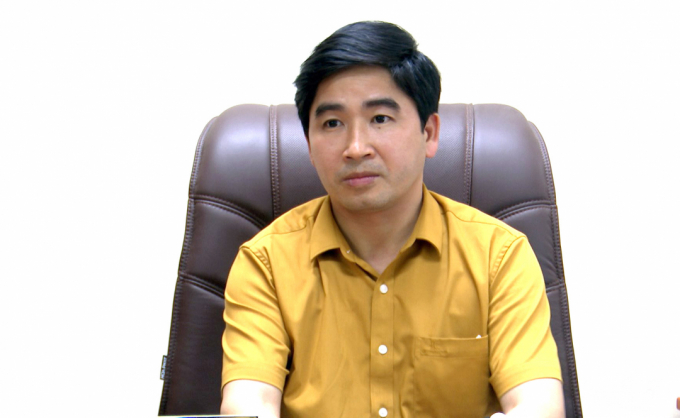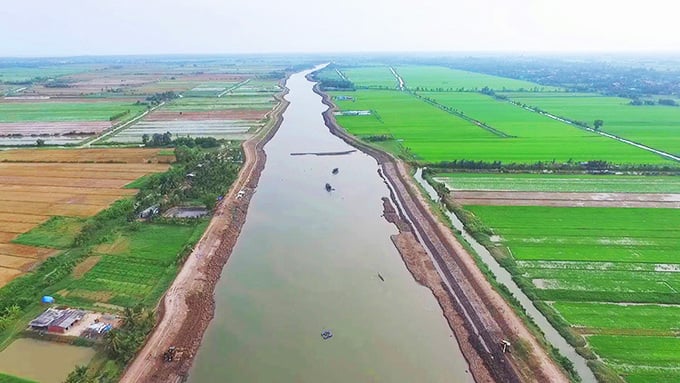December 31, 2025 | 14:33 GMT +7
December 31, 2025 | 14:33 GMT +7
Hotline: 0913.378.918
December 31, 2025 | 14:33 GMT +7
Hotline: 0913.378.918
After 4 years of implementing Resolution 120 of the Government, a large amount of resources has been mobilized to invest in the development of irrigation infrastructure in the Mekong Delta. As a result, the management of water sources for production and in service of people’s needs has been significantly improved.
In order for the irrigation industry to continue promoting its leading role, effectively serving the restructuring of the agricultural sector for the Mekong Delta, the Vietnam Agriculture Newspaper had an interview with Mr. Luong Van Anh, Deputy Director of the Directorate of Water Resources (MARD).

Mr. Luong Van Anh, Deputy Director of the Directorate of Water Resources (MARD).
Can you tell us about the major difficulties and challenges in the irrigation development of the Mekong Delta at present and in the future?
Irrigation in the Mekong Delta is currently facing three major challenges: Changes in exploitation from upstream, impacts from the sea, and the development problem within the Mekong Delta itself.
Regarding the changes in exploitation from upstream, there are currently 74 reservoirs in which the amount of water has increased rapidly over the years (in 2001 it was 15 billion m3, in 2011 it increased to 30 billion m3, in 2018 it reached 49 billion m3 and it is expected that in 2030 it will continue to increase to 95 billion m3).
Countries in the upstream such as Thailand, Laos, and Cambodia have attained many developments in agriculture, water conduction and water transfer activities in the upstream are accordingly further-progressed. Meanwhile, the Mekong Delta in Vietnam is the end point of the stream, so the amount of mud and agricultural waste from upstream flows down a lot, greatly affecting the production and aquaculture activities of the people.
In regard to the impacts from the sea, sea level in the recent 30 years has risen by about 20 cm. High tide combined with strong winds increases the tidal range. Particularly in recent times, high tide occurred during the drought season. The low amount of water upstream at that time combined with high tides have worsened the situation of saltwater intrusion.
As for the development problem within the Mekong Delta, according to statistics, the area of rice, aquaculture and fruit trees is constantly increasing. When agricultural production increases, the demand for irrigation water increases. This puts great pressure on the irrigation system, and many overloaded works have shown signs of deterioration. The exploitation of groundwater for aquaculture and fruit tree plantation has also taken place actively which lowers the groundwater level, increasing land subsidence.
It is known that the MARD is constructing an irrigation development plan in the Mekong Delta. Can you tell us more about the views and goals defined in this plan?
In regard to the views, the Directorate of Water Resources is currently based on the strategy on irrigation approved by the Prime Minister, the natural disaster prevention strategy to 2030 with orientation to 2050 and Resolution 120 of the Government on the Mekong Delta’s sustainable development in response to climate change, having water resources as the core.
On that basis, the Directorate of Water Resources has established the goal of ensuring the synchrony of irrigation works construction, meeting the agricultural industry’s demand for water supply and other purposes, prioritizing civil services, and at the same time guaranteeing the prevention of drought and saltwater intrusion in the coming time.

One million m3 freshwater reservoir at Ba Tri, Ben Tre. Photo: Hoang Nam.
Upon the requirement to shift the Mekong Delta’s key product axes in the direction of reducing rice and increasing seafood, fruits and vegetables, in your opinion, should irrigation planning go before or after other economic sectors?
In accordance with the spirit of Resolution 120 approved by the Government in which water resource is the core, the irrigation sector needs to take the first step in order to orient and become the center for the development of the agricultural industry and industries with great water demand, and especially meet domestic water consumption needs in the Mekong Delta.
During the recent shift of key products in the Mekong Delta, notably the record drought and saltwater intrusion in 2020, it is the irrigation works that have greatly contributed to regulating saltwater and fresh water. The works had helped the agricultural industry become proactive in water resources, push the rice crop earlier, leading to great success.
As for fruit trees and domestic water, when we predict that the amount of water coming from the upstream will be low, irrigation works will play the role of water storage and secure enough water for living, aquaculture, fruit, thereby reducing potential damage to people.
Thank you, sir!
Translated by Samuel Pham

(VAN) From extensive shrimp ponds, baskets of don gathered on the mudflats, to boats carrying visitors to watch birds, all livelihoods here depend on clean water, green forests, and the calls of migratory birds.
/2025/12/26/0703-3-204813_117.jpg)
(VAN) Transparency in information and listening to local people have helped address ground clearance bottlenecks and build social consensus, thereby accelerating the progress of the JICA3 irrigation project.
/2025/12/27/0609-3-233846_327.jpg)
(VAN) The JICA3 project is expected to become a 'water shield,' helping control saltwater intrusion, proactively secure water resources, protect livelihoods, and promote sustainable development in coastal areas.
/2025/12/26/5654-3-164509_655.jpg)
(VAN) As Viet Nam makes strong commitments toward achieving net-zero emissions, controlling and reducing methane emissions in livestock production is increasingly becoming a mandatory requirement.

(VAN) 'People, Primates, Plants: Co-managing Biodiversity and Improving Livelihoods in Vietnam' (the PPP Project) is an international initiative implemented in Vietnam by BGCI, CEGORN, and ICRAF/World Agroforestry.

(VAN) Dak Nong established a risk-level zoning map for coffee, built a digital data platform for the sector, and promoted certified production in line with EUDR.
/2025/12/25/2709-1-211551_295.jpg)
(VAN) In response to the U.S. Marine Mammal Protection Act (MMPA), Gia Lai province is implementing many solutions to protect marine mammals and develop sustainable, responsible fisheries.